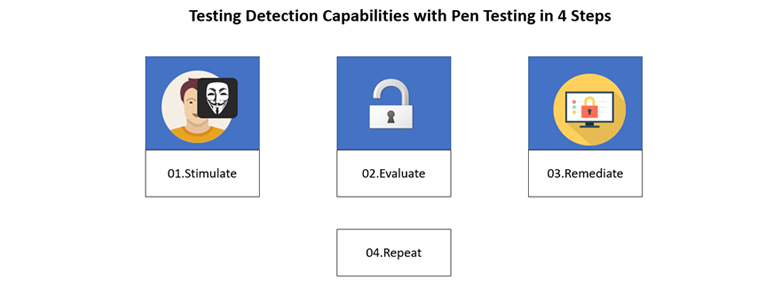Test Your Detection Capabilities with Penetration Testing
The most common news we hear in this digital era is regarding cyber-attacks. It frightens the business, panics the users, and damages the reputation. Organizations are increasingly adopting various security solutions to prevent and mitigate the cyber threats that attackers now employ. Some businesses think that the more automated security tools they deploy, the better secure they are.
However, while investing in security tools, they often overlook the importance of testing whether their security solutions actually work or if preventive measures have any loopholes that hackers can exploit.
The reality is that it only takes a single vulnerability for attackers to successfully exploit a severe attack. Moreover, the only factor worse than a security breach you’ve discovered is one you haven’t discovered.
How do you ensure your detection capability can mitigate sophisticated cyber-attacks?
Those days are gone where you depend on a quarterly or annual security test result. In the current era, you need continuous assets scanning, advanced security testing against real-time attacks, and of course, protection.
To expose the gaps in your security posture, it is significant to test your defense capabilities by proceeding offensively on your applications and networks. Fortunately, this can be performed through penetration testing.
What Is Security Penetration Testing?
Penetration testing aids to interrupt, to know how, why, and when a cybercriminal can infiltrate your network. With web application penetration testing, testers examine how far they can go in hacking your confidential assets by using similar methods used by real-world cyber attackers. It simulates real-world scenarios customize to your website which is different than generic automated testing. Most businesses think penetration tests are only for a periodic vulnerability assessment or a compliance audit. However, effective web application penetration testing services go way beyond this.
Importance of Assessment Against Real-Time Attack Scenario
To stand up against the latest advanced threats, it is crucial to regularly assess the effectiveness of cybersecurity. As with the requirement to test disaster recovery and business continuity plans, penetration testing for evaluating the strength of cybersecurity procedures and controls in place is also advantageous for mitigating security risk.
A real attack simulation can support an organization to prepare for worst-case scenarios, calculate potential damage, and aid to optimize future security investments.
Framework of Penetration Tests to Check Detection Capabilities
The security penetration testing simulates the kind of attacks an adversary might execute against the given network or system. This exploitation is focused on evaluating not just the security posture of your network, but also the capability of your security team to detect and restrain these activities.
These penetration tests extend the traditional security testing to understand the resiliency of your cyber program to protect against this kind of attack and to understand where blind spots and gaps exist within the network. This gives your team the chance to practice effective incident response and threat hunting.

This kind of penetration testing usually involves attempting to get access to a corrupted, damaged, or highly secure app or database, exploiting as well as stealing sensitive information like passwords, or even breaking into email accounts. However, these kinds of immoral activities performed by pen testers are completely for good reasons. With the common goal of detecting security vulnerabilities and suggesting possible steps to address that gap, the penetration testers employ a variety of hacking techniques including SQL-injection attack, SSH tunneling, DDoS attack, and SSL stripping.
Examples of Penetration Testing
Here are some of the ways the penetration testers test the attack vectors and your solutions, which protect them:
Test Your Email Defense – This attack simulation involves sending malicious emails to your email service with infected file attachments to test anti-virus software, email filters, and sanitization solutions.
Check the Capability of Your Firewall – This method attempts to attack a certain URL like your application or web portal to bypass the firewall, which protects it. It checks whether your web application firewall can block incoming malicious traffic. To take this attack to the next level, pen testers can also attempt to carry out injection and XSS attacks to breach the WAF.
Identify Gaps in Your Website Defense – This penetrating testing technique connects to pages containing malicious scripts and forms through HTTPS protocol to examine whether the endpoint protection can defend malicious files from being downloaded.
Using Social Engineering Tactics – Pen testers can also launch dummy phishing campaigns to stimulate social engineering attacks. This aids you to determine which employees are the weakest links and require more training in security awareness.
Test the Defense of Endpoint Security Solutions – Penetration tests can also test as well as map out how malware like ransomware, viruses, worms, and spyware can spread across your devices. This method detects whether your security solutions can detect and stop the spread of malware.
All these techniques are used by pen testers for the sake of enhancing your application security. The report of the penetration tests contains details to correlate activities executed against your detection systems. It gives a general idea of what methods were used to achieve entry, what apps were compromised, and many more.
Conclusion
Just because you deployed an enterprise-grade security solution does not mean your defense are impassable. It is important to test your defenses to maximize the cybersecurity investments and make sure you are always protected.
Want to prepare for the worst-case? Click here to learn more about our penetration testing services.


 April 27, 2021
April 27, 2021






